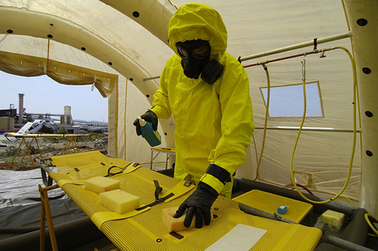Jan 17 2013
Arizona State University’s Biodesign Institute has announced a partnership with Life Technologies Corporation as it enters the next phase of a multi-million-dollar, multi-institutional research project to develop a medical device to rapidly assess an individual’s exposure to radiation in the event of a nuclear incident.
 ASU and Life Technologies partnership
ASU and Life Technologies partnership
The project enters a $9.33 million contract option as part of a five-year, $35.44 million project funded by the Biomedical Advanced Research and Development Authority (BARDA) within the Office of the Assistant Secretary for Preparedness and Response, U.S. Department of Health and Human Services. This phase will focus on prototype development of a gene-expression based system for individuals exposed to abnormal levels of radiation.
“We are pleased that Life Technologies is joining our team as a commercial partner,” said Lee Cheatham, deputy director of ASU’s Biodesign Institute and lead investigator of the project. “We have completed initial scientific feasibility and now must develop a working device. Life Technologies’ experience in delivering FDA-cleared assay systems to the marketplace is a great fit for this project. Their strong product focus will ensure that we develop for BARDA an effective and easy-to-use system.”
“In the event of a nuclear emergency, potentially thousands of people would need to be screened per day,” said Ronnie Andrews, president of medical sciences at Life Technologies. “We are very proud of the robustness of our instruments that they would be selected for this type of application.”
The partnership is designed to develop genetic assays that would be run on several Life Technologies real-time PCR instruments including the Applied Biosystems 7500 Fast Dx and the QuantStudio Dx. All of these instruments perform a reaction called real-time PCR (polymerase chain reaction), a method of rapidly producing DNA from a small starting amount, detecting genetic matches if present and reporting the results.
Since the project was launched in 2010, ASU has led the research activities, demonstrating that the science of gene expression is a viable approach to directly measure radiation exposure. Of the 11 project teams launched in 2010, the ASU team is one of six continuing development.
Developing the system required the identification and validation of biomarker signatures to provide an accurate indication for the level of absorbed radiation. Joshua LaBaer, director of the institute’s Virginia G. Piper Center for Personalized Diagnostics is leading the biomarker effort. Sally Amundson, Columbia University Medical Center in New York City, is providing extensive experience in the identification of radiation responsive genes and biodosimetry measurements. Researchers from Translational Genomics Institute in Phoenix, HTG Molecular in Tucson, and the University of Arizona have also contributed to the early phases of the project.
The ASU effort is part of BARDA’s congressionally mandated program to develop medical countermeasures against chemical, biological, radiological and nuclear threats, and against pandemic influenza and emerging infectious disease outbreaks and other natural and intentional threats to public health.
Source: http://www.asu.edu/